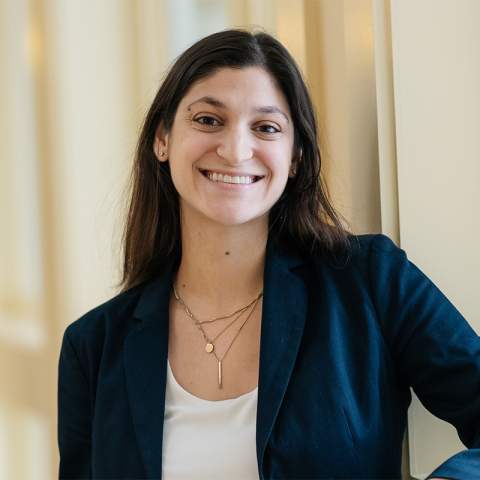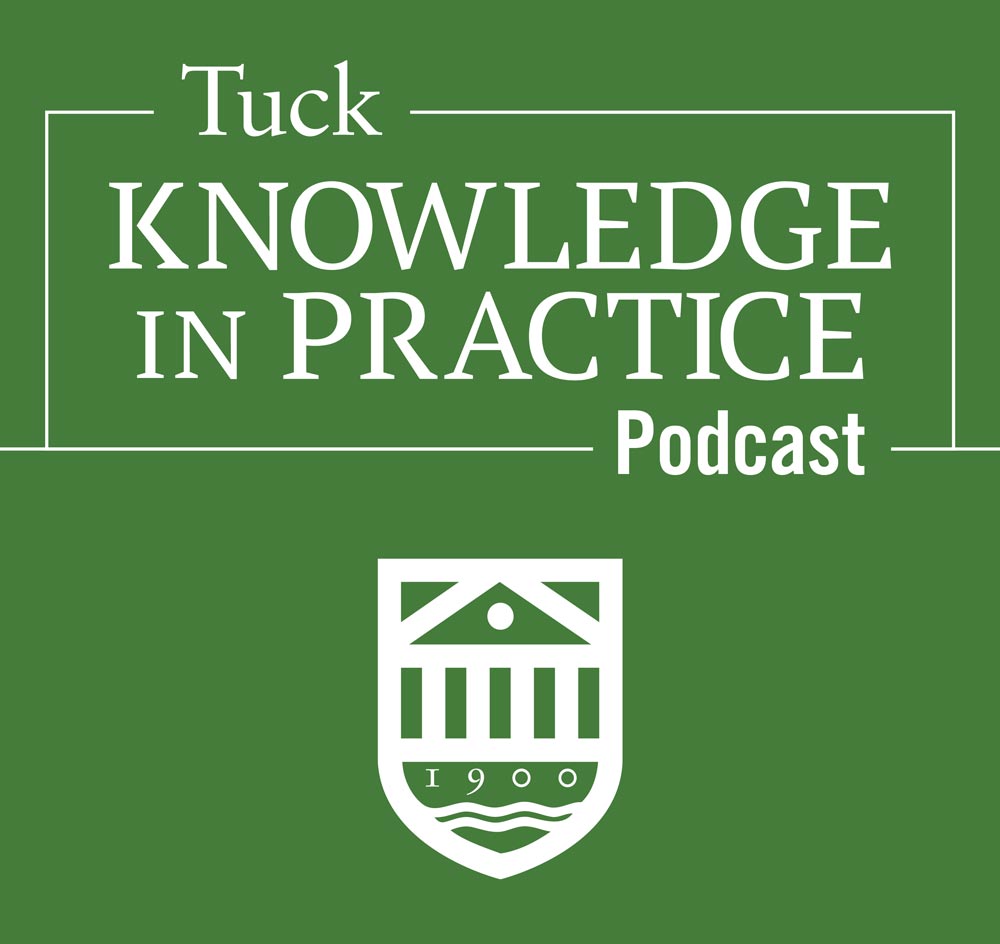Tuck Knowledge in Practice Podcast: How to Boost Market Accessibility for People with Disabilities
Tuck professor Lauren Grewal discusses her new study that investigates potential reasons for why marketplace disability accessibility has not been universally accepted.
Upwards of 83 million people in the U.S. have a disability, but firms still struggle to make their goods and services accessible to everyone. Part of the challenge is that non-disabled people view accessibility accommodations as tradeoffs against other interests, such as environmental stewardship and convenience, and they are loath to make those sacrifices.
In this episode of the Knowledge in Practice Podcast, Tuck professor Lauren Grewal discusses her paper on this topic: “Hidden Barriers to Marketplace Disability Accessibility: An Empirical Analysis of the Role of Perceived Trade-Offs,” which was published in the Journal of Consumer Research in 2024. In it, she finds that if firms clearly communicate the rationale for and benefits of their accessibility efforts, non-disabled people will be more likely to accept and appreciate them.
“I thought if we could understand how allies could be created from those without disabilities, and how to make them supportive of business tactics that are actually aimed at creating better accessibility,” Grewal says, “then there’s a way to actually provide easy, straightforward paths for companies to do more and to not always put the onus of responsibility on those with disabilities to advocate for themselves, but to get others to advocate for them as well.”
Research paper discussed: Hidden Barriers to Marketplace Disability Accessibility: An Empirical Analysis of the Role of Perceived Trade-Offs
Listen Now
Our Guest

Transcript
[This text may not be in its final form and may be updated or revised in the future. Accuracy and availability may vary. The authoritative record of the Tuck Knowledge in Practice Podcast is the audio record.]
Lauren Grewal: I don't ever want to advocate saying, let's do research on disability and individuals’ experience living with disability without having that voice acknowledged. I thought if we could understand how allies could be created from those without disabilities and how to make them supportive of business tactics that are actually aimed at creating better accessibility, then there's a way to actually provide an easy, straightforward paths for companies to do more, and to not always put the onus of responsibility on those with disabilities to advocate for themselves, but to maybe get others to advocate for them as well.
[Podcast introduction and music]
Kirk Kardashian: Hey, this is Kirk Kardashian, and you're listening to Knowledge and Practice, a podcast from the Tuck School of Business at Dartmouth. In this podcast, we talk with tuck professors about their research and teaching and the story behind their curiosity. Today on the show, I speak with Lauren Grewal, an associate professor of business administration and the Paul E Raether T’73 Faculty Fellow. Lauren’s research examines identity-based consumption, how consumers use and process digital and social media, and consumer wellbeing. To do this, she uses a multi-method approach of behavioral experiments, real world data, and field studies. In this episode, Lauren discusses a new paper on how to make goods and services more accessible for people with disabilities. She finds that non-disabled people perceive accessibility accommodations as tradeoffs against other interests, such as environmental conservation and convenience. To counteract those perceptions, Lauren recommends firms reframe Aim accessibility as something that benefits a wide variety of customers and communicate clearly about the purpose of the accessibility features. Okay, Lauren Grewal. Thank you for making some time for us on the Tuck Knowledge and Practice podcast. It's great to see you, and I'm excited to talk about this paper with you. The paper we're discussing is called Hidden Barriers to Marketplace Disability Accessibility, an empirical analysis of the role of perceived tradeoffs.
Lauren: It rolls off the tongue, doesn't it?
Kirk: It does. It's kind of a mouthful, but it rolls off the tongue. And this paper was published this year in the Journal of Consumer Research. As you say in your paper, disabilities affect 25% of the US population, which is roughly 83 million people. And yet there are many instances where people with disabilities have difficulty using the marketplace. So just to get us started and to orient us around this problem, I wondered if you could talk about a few marketplace accessibility problems that people with disabilities have in their daily life? Where does this come up as an issue for people?
Lauren: Disabilities are wide spanning. I think to orient listeners to kind of what a marketplace issue could be, we have to define disabilities. In this case, when I'm talking about disabilities, I am talking about physical or mental impairments that can limit someone's life or their activities. It can be having a history of an impairment, or it could even be that someone is perceived as having some sort of impairment by others. When we think about disabilities, when we think of physical disabilities, oftentimes you think of the picture of somebody in a wheelchair. And I think that might be the easiest example to visualize, where let's imagine you are in a wheelchair and you want to go into a store. ADA policy will say you need a ramp to get into the store. Great. You're in the store now. You've gone up the ramp. Now, are the aisles wide enough? Or are they just above ADA minimums? Are you able to really easily navigate? What happens if a store is crowded? What happens when there are things that are higher up on the shelves just from, like these small kinds of day-to-day kind of outings, you've now made it more difficult. But basically when I think about disabilities and when we think about disabilities, people usually have one picture in their mind of what counts and kind of ignore the rest of the population that can fall under this category of maybe needing a little bit of extra accessibility. Which is why the typical consumer says not that many people have disabilities or there aren't that many people to accommodate, even though the statistics don't lie, and especially with things like Covid, we are more likely going to see a trend of a higher percentage of the population having disabilities in the future. And so, it's just one of those factors that is less salient, unless it is something you already live with or see in your daily life. There's just so many little things in the marketplace that we might not be aware of.
Kirk: And your paper investigates the consumer perceptions, such as zero sum thinking that might be behind firms’ failure to adequately serve people with disabilities. What you're doing here is thinking about how non-disabled people's perceptions of the tradeoffs that might be involved with offering accessibility to people with disabilities, how those tradeoffs might hurt them. What was your motivation to study this, and to do so through the lens of these perceived tradeoffs?
Lauren: So I've always had an interest in understanding the experience of consumers who live with disabilities, and the question of the tradeoffs in particular, and this other perspective active of non-disabled consumers came about a few years ago. It was around the time that Starbucks was talking about a plastic straw ban. A lot of consumers and a lot of oped pieces were talking about how this was such an amazing decision for sustainability, how they would be making real strides, how we'd be reducing our use of plastics. “Single use plastics are terrible. Hooray, Starbucks!” But in a smaller corner of the internet, there were all these opeds also coming out from disability advocates saying, hey, what about us? You're taking away something that we could utilize as well. And there were all these infographics and nuances to how all these alternative types of straws, for example, were actually non-accessible. Like, metal could be dangerous for somebody with seizure disorder. Papers could be too flimsy for some, like the cups that don't have straws at all, which is what you commonly see even in our Starbucks in town. Like if you have shaky hands or less dexterity, that's more likely to spill. So it's just like talking about all these little things that it's like, yes, we're really happy we care about the environment too, but can we address sustainability with something that doesn't necessarily harm us? Starbucks’ official answer to this was to say, you can ask the barista, we will keep plastic straws in the back, and anybody can ask for it and receive one.
Lauren: You just kind of have to opt in versus opting out. And we know that opting in versus opting out does change usage and can be a way of changing behavior for the good. Like if we're thinking of organ donations, that's one of the big things that's been talked about. But then you're asking people to potentially put themselves in less than safe conditions by saying, I need a plastic straw to a person who does not know you. And let's say you have a less visible disability. They could be judging you. They could flat out say no. They could make you feel bad. They could ask you why. And then you are now in a place where you have to self-disclose and identity that you don't necessarily want to disclose. And all of these conversations were popping up, and I wanted to understand when would firms possibly put the needs of consumers with accessibility concerns or disabilities at the forefront over potentially other major CSR considerations like sustainability? And I kept trying to look into the literature for options related to accessibility for those with disabilities.
Lauren: And I was finding over and over again situations where it was read as a tradeoff rather than as a, “Here is one thing that we were doing, and it is just a good thing,” which was surprising to me because when you talk about sustainability, this is a good thing. You don't really acknowledge the tradeoffs versus it was coming up again and again for accessibility. Like here's what the tradeoff would be like. We can offer this. But and this was also true around the same time, Whole Foods offered pre-peeled oranges and pre-packaged vegetables and things like that. And people went nuts on the internet saying, this is too much plastic. This is only for lazy people. This is unnecessary. This is just charging us more money for something we don't need. And again, there's like the smaller voices in the internet saying, I can't peel an orange. This would be nice. Don't I deserve fresh fruit too? So just like small things like that were catching my interest. And it's something I wanted to explore.
Kirk: Yeah, yeah. And it seems like that vocal group of people, I guess I don't know, I'm not sure if complaining is the right word, but complaining about the environmental effects of offering plastic straws. Or the environmental effects of offering prepackaged fruit, like those people who are complaining about that sort of thing. They're kind of like a vocal group, right? I mean, they and they can sway firms decisions to offer these things or not, right?
Lauren: Yeah. We've talked a lot in the literature about like, vocal minorities being able to have a lot of power. But what I found interesting with the case of disability accessibility is that the group that had the most power was actually the majority, in that they're not necessarily always going to be vocally against changes, but it was the vocal minority from the majority group that was actively making it harder for those individuals who might not have the same power to speak up and enact change. And the literature thus far has very rightly focused on the voices of those with disabilities, as they should. That is a critical piece that should never be ignored. But I thought if we could understand how allies could be created from those without disabilities and how to make them supportive of business tactics that are actually aimed at creating better accessibility, then there is a way to actually provide easy, straight forward paths for companies to do more, and to not always put the onus of responsibility on those with disabilities to advocate for themselves, but to maybe get others to advocate for them as well.
Kirk: That leads me into my question. In this paper, you sought not only to better understand the barriers to accessibility, but also to come up with some ways around those barriers. Tell us about your goals with the study and how you conducted your experiments.
Lauren: In this paper it was for a special issue. So the paper actually had to be shorter than most of our academic papers. So it only has three experiments in it. And in this one project, we basically were just trying to understand at the micro level, which is what we refer to as the individual level. How are they viewing more accessible product offerings when it comes at a potential detriment to themselves, and what we can do in the framing of those product offerings to make it seem more beneficial to everybody. Taking away any of the negativity associated with here is a product offering that might not necessarily be for you. We were doing this through experimentation, looking at mostly non-disabled populations, but we did run some of our studies where we tried to hold constant. If the population was 50% identified as having a disability versus 50% did not identify as having it, and trying to find the same effects across the board. I have multiple conditions where the only thing I'm changing is the framing of how an accessible offering is discussed for the more micro level individual one. It's like the store is offering more accessible goods. However, all groceries, for example, might cost a few more dollars total in your shopping trip versus changing the framing. To be like this is something that benefits people with mobility concerns, mothers with strollers. So just kind of like changing the framing of, hey, we're making this decision that you might not like. We're raising prices, but here is why. And talking about it in different ways, and trying to do it in such a way that consumers say, okay, this makes sense, or I'm okay with how this works.
Lauren: It's like if a firm were to say, “I have this product, $5.” If it goes to charity, usually people are okay spending a few more dollars, right? Because this helps others. And it's just in this situation figuring out how to frame it so that people aren't upset at something that they think only helps a small portion of the population. And then we did one experiment where people were seeing information about plastic straws, where they either knew about the accessibility component of plastic straws, or they did not know about the accessibility of plastic straws. And looking at how they view a firm for offering it. And then we also looked at sustainability with like the pre-peeled fruit having different labels. So understanding why there's an orange that's pre-peeled versus just seeing a pre-peeled put in plastic orange. Like, how are people going to understand that if it looks accessible versus not? All participants had an equal shot of being in any condition in our studies. They were all recruited online. We tried to have fairly representative demographics of the country. We focused on all us participants and we collected data related to their age, their gender identification. If they felt as though they lived with a disability or not, do they identify as having one or not? Which are different questions? Do they think about accessibility in their daily life? We got all of this extra information and just looked at all the data.
Kirk: So let's talk about the results from the framing study. When you frame it as a increased cost due to the accessibility, there is there was a result that you might expect is that people kind of had a negative reaction to it, right? But when you frame it as having a benefit for these different populations and maybe for the consumer themselves, they were more open to it. They were less negative or more positive to it. Right.
Lauren: Yeah. So if we look at the control condition of evaluations towards a firm that was always higher than the accessible conditions, whether it's accessible, baseline, accessible, benefiting just others generally, or the accessible benefiting of others and the self. It's still higher. Always in the control people, no matter what. They don't want to pay more money in these situations.
However, we started seeing much higher evaluations back towards that initial control in accessibility when it benefits others in the self compared to just benefiting others versus that just it is an accessible thing and it's at the baseline. Our goal for this paper wasn't to say at any point accessibility is better than baseline per se. But how do we get back to that baseline where if a firm chooses to go out on a limb and offer more accessibility, how can they do so without being punished? Because that's what we were seeing in the media, was more punishment rather than anyone praising the good work they're doing. And there's so many firms that are actually doing fantastic work for accessibility, either for employees or for customers in other ways. And that's also never being talked about. And I'm wondering if part of the backlash that has been seen generally is why some firms aren't overly talking about all the good that they are doing.
Kirk: Yeah. So we can kind of, skip ahead to your main findings from the paper. What do you think the sort of key takeaways are for firms as they try to think about making their products and services more accessible? How can they make it more palatable for non-disabled people? How can they make it less of a of a trade off?
Lauren: Well, number one, it depends on what type of accessibility they're offering. I don't believe that it's always a tradeoff. And I'm focused here on things like product offerings or service offerings, where there will be some sort of trade off, where a firm has finite resources and they can't just do everything for every cause and every consumer. But for those instances, a key takeaway here is to understand who is kind of taking in the cost component of the tradeoff. If you think it's the consumer who's bearing the weight of the firm's decisions to be more accessible, whether it's through reduced product offerings, longer wait times, maybe less parking, maybe less availability to shop, etc. whatever it might be, how can you frame it as yes, this helps this part of the population, but here are the benefits generally. Like how can we help more people with what we're doing? And if it's a firm that's having to say we only have the ability to do a finite number of good things, how can we make sure people understand that the decisions we're making are not us Foregoing this other good cause, but us actually acknowledging this other important thing that we want to acknowledge. So it's not that we don't care about sustainability, it's that we also care about offering some accessibility. Maybe we focus our sustainability efforts within the firm to the less visible things that consumers don't deal with on a day-to-day basis, while making the consumer experience as accessible as possible, and making sure that consumers know that.
Lauren: Making sure it's very obvious that the pre-peeled prepackaged orange is not just for, you know, raising the cost of an orange and saying, we're just making oranges more expensive and less accessible to the general population from an affordability point of view, but instead saying we will have some options of produce available for those who might need something pre-peeled. And especially in the age post Covid, I think people are more willing to accept something where it's been pre-done and then packaged safely, because a lot of stores otherwise were saying you could go up to a store employee and have them peel something in front of you and then buy that, but then that involves a lot of health concerns and someone touching your food right in front of you, which gives people the heebie jeebies in a very professional way of saying it, versus having something that's already looking like it's clean and safe and that you can walk away with it. So I do think also just looking at this five years from now will be an interesting question on what's considered acceptable kind of accessibility as more and more people have become comfortable with variations in accommodations.
Lauren: And I started this project initially pre-Covid, worked on it during Covid, and now it's being published, quote unquote, post-Covid. And it's just been very interesting to see kind of the tides of how the public talks about different types of accessibility. The level of accommodations and accessibility increased dramatically during the pandemic. Zoom classes, for example, conferences that were accessible online, affordable options for people to be involved in various aspects of the world increased. Those all disappeared again as soon as people thought it was safe to go back outside. We have proven that we can do grocery store deliveries. We have proven that we can make aisles clean. We have proven that we can make accommodations for people when we think it's the majority. And it all kind of came down to a trickle or to even a stop in a lot of places, as soon as it was seen as no longer being necessary for the majority. And so one of my hopes with my research is to not get us back to, you know, paranoia or anything terrible. I don't want us to say let's live inside and not interact. But we know businesses can accommodate. How can we continue doing so and do so without backlash from maybe our investors, our employees, and our customers?
Kirk: I'd like to thank my guest, Lauren Grewal. You have been listening to Knowledge and Practice, a podcast from the Tuck School of Business at Dartmouth. Please like and subscribe to the show and if you enjoyed it, then please write a review as it helps people find the show. This show was recorded by me, Kirk Kardashian. It was produced and sound designed by Tom Whalley. See you next time.
[podcast outro and music]
Kirk: Yo, T-Bone, did you produce this?
Speaker3: Sounds good. Right?



